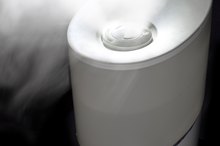What does fact checked mean?
At Healthfully, we strive to deliver objective content that is accurate and up-to-date. Our team periodically reviews articles in order to ensure content quality. The sources cited below consist of evidence from peer-reviewed journals, prominent medical organizations, academic associations, and government data.
- "Environmental Research": Lead Levels in New Enamel Household Paints from Asia, Africa and South America
- "Environmental Research": Lead Levels in New Enamel Household Paints from Asia, Africa and South America
- "Scandinavian Journal of Work, Environment and Health": Organic Solvent Neurotoxicity
- "Scandinavian Journal of Work, Environment and Health": Organic Solvent Neurotoxicity
The information contained on this site is for informational purposes only, and should not be used as a substitute for the advice of a professional health care provider. Please check with the appropriate physician regarding health questions and concerns. Although we strive to deliver accurate and up-to-date information, no guarantee to that effect is made.
Toxic Effects on Brain From Enamel Paint
Painting a house can present some serious health hazards: Enamel paint and other paints often contain volatile organic compounds (VOCs) that can have toxic effects on the brain and body. Working with these solvents requires special protective measures. What are these chemicals, what are their effects and how can you protect yourself?
Types
Enamel paint may contain a wide variety of solvents. Automotive enamel paint typically contains larger quantities and more dangerous versions of these compounds than house paint, and outdoor house paint presents a more toxic profile than indoor house paint.
Typical toxic solvents used in enamel paint and other household chemicals include toluene, also known as methylbenzene; benzene; ethylbenzene; and xylenes, according to the Ohio Bureau of Environmental Health. Mineral spirits (also known as white spirit or Stoddard solvent) may occur in paint and can also have neurotoxic effects. Acetone, also used as an enamel paint solvent, has a much lower toxicity.
- Enamel paint may contain a wide variety of solvents.
- Mineral spirits (also known as white spirit or Stoddard solvent) may occur in paint and can also have neurotoxic effects.
Considerations
Toxic Vapors Emitted From New Tires
Learn More
In addition to the above solvents, enamel paint may also contain lead. While U.S. and most European manufacturers no longer make lead paint due to regulatory bans, paints from many countries in Asia, Africa and South America may still have a high lead content, according to an October 2009 article in the journal "Environmental Research." Lead can cause permanent brain damage, leading to cognitive and physical impairment 1.
Effects
Exposure to solvents such as:
- dizziness
- headache
- poor coordination
Prevention/Solution
The Effects of Inhaling Computer Cleaner
Learn More
For indoor painting, exposure to toxic VOCs in enamel paint can be avoided completely: U.S. manufacturers from Dutch Boy to Miller to Benjamin Moore all sell low and zero-VOC interior paints in a wide range of colors. These paints also have a significant convenience advantage; they dry quickly, and barely give off any odor, allowing the building to return to use shortly after painters finish their work.
Low-VOC exterior paints are not as easy to acquire. A few boutique paint suppliers like Yolo Colorhouse have begun offering them, but in general, finding less-toxic paint for outside work can be difficult. Fortunately, outside areas offer better ventilation, leading to less exposure to these toxic solvents.
- For indoor painting, exposure to toxic VOCs in enamel paint can be avoided completely: U.S. manufacturers from Dutch Boy to Miller to Benjamin Moore all sell low and zero-VOC interior paints in a wide range of colors.
- A few boutique paint suppliers like Yolo Colorhouse have begun offering them, but in general, finding less-toxic paint for outside work can be difficult.
Warning
When working with enamel paint that contains a high quantity of solvents—whether painting a house, a car, or a smaller project—make sure the area is as well-ventilated as possible. If still in doubt, wear a respirator mask to prevent the toxic effects of solvent inhalation. Paper masks do not block solvent fumes. These safety measures have particular importance when working with spray paints, which can put equally toxic propellants into the air as well. Even outdoors, a respirator helps to limit exposure.
- When working with enamel paint that contains a high quantity of solvents—whether painting a house, a car, or a smaller project—make sure the area is as well-ventilated as possible.
- These safety measures have particular importance when working with spray paints, which can put equally toxic propellants into the air as well.
Related Articles
References
Writer Bio
Eri Luxton holds a B.A. in liberal arts, an M.F.A. in creative writing, a first aid certification and a biomedical ethics certificate. She has worked as an English teacher overseas and as a local volunteer in first aid and in technology troubleshooting. Luxton mentors students in chemistry and physics while studying toward a pre-health sciences degree.









